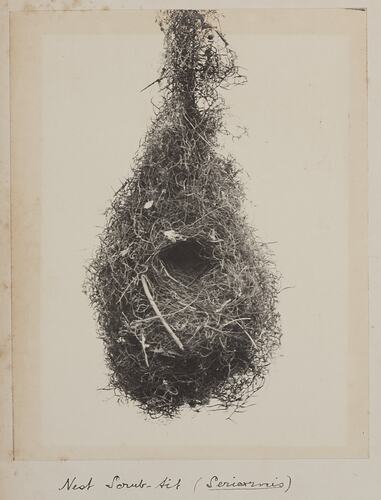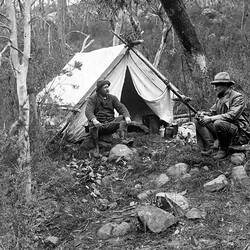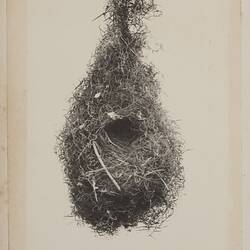YELLOW-THROATED SCRUB WREN (SERICORNIS CITREOGULARIS, Gould.-(213)
Geographical Distribution-Queensland, New South Wales and Victoria (Eastern).
Nest.-Bulky, bottle or pear-shaped, with hooded side entrance; outwardly composed of trails of beautiful golden-green moss with a mixture o black thread-like rootlets, especially about the entrance; occasionally a few dead leaves are interwoven; lined inside with soft grasses and a plentiful supply of feathers &c. Usually suspended by the neck from a low branch or lawyer palm (Calamus) cane in thick scrub, more frequently overhanging a water-course Dimensions: length 15 or 16 inches; diameter in broadest part 5 inches, in narrowest 1 ½ to 2 inches; entrance 1 inch across.
Eggs.-Clutch, two to three; elongated or long oval in form: texture of shell fine surface glossy; colour, varies from vinaceous to light purplish-buff, usually of a darker shade on the apex, or with a belt of indistinct markings of dark purplish-brown or umber. Some specimens resemble in a remarkable degree the colour of a ripe acorn. Dimensions in inches of a proper pair: (1) 1.08 x .67, (2) .99 x .69; of a slightly shorter pair: (1) .98 x .7, (2) l98 x .7. (Plate 11.)
Observations.-This, the finest and largest of these dull-coloured but interesting and active birds, inhabits the dense tropical scrubs of Queensland and New South Wales. I have observed it at home in both States, taking many nests and eggs in the Big Scrub of the latter locality, where the birds are numerous. Mr. Kendall Broadbent states that the Yellow-breasted Scrub Wren finds its way as far south as Victoria, and he often found it when shooting in Gippsland many years ago. He never found it as far north as Cape York. Rockingham Bay seemed to be its northern limit.
Here is a serene gully where every tree stem is decorated with moss of different species, where the walking-stick palms wave their crown in contrast to the bright-green erect crests of ferns, and where large semi-transparent leaves, aloft of the stinging-tree, are backed up by the dark thick foliage of bean-trees, all overshadowing here and there clear rocky pools of water! In such places do the Yellow-throated Scrub Wrens love to hang out their golden-green nests composed of matted mosses.
I can bear testimony to that part of Gould's statement which says that the pear-shaped, perpendicular, mossy nests are exceedingly attractive when observed hanging in the humid scrub. But the Sericornis does not construct its home within the mossy masses, but rather gathers the moss and masses it into a wonderful and beautiful nest, which is hung out in the 'corridors' of the scrub, as if to attract the attention of passers by, or perhaps, more correctly speaking, made to assimilate the pendulous mossy ornaments of the forest in order to put the birds; natural enemies 'off the scent.' (See illustration.)
Repeating in part my technical description of the nest, it is decidedly bulk (about 18 inches in circum-ference at the broadest part) in comparison with the size of the owner, and outwardly constructed of beautiful string-like, golden-green moss, which covers a ply of wiry rootlets, then comes a copious lining of feathers of various scrub birds.
In one nest I detected Cat, Regent, and Satin Birds', Brown and Wonga Pigeons' and, I fancy, Lyre Birds' feathers.
Gould has accurately described the eggs, which, as a field naturalist once aptly mentioned, resemble ripe acorns.
Dr. Ramsay, in 1866, took both nests and eggs in the same district (zoologically speaking) where I obtained mine.
Speaking of the Yellow-throated and Large-billed Scrub Wrens in Southern Queensland, where they are called "Devil Birds,'" Mr. H. Lau says:- 'There are two (major and minor), both inhabitants of the dense sea-coast scrubs, where the birds may be met with in the darkest places alongside mountain streams, where neither sun or moon can penetrate (hence the name "Devil Birds").
"In many cases the nests hang within reach of man.Bats like such abodes, taking the deserted summer dwellings for their winter quarters."
Breeding months August to December or January, the chief month for fresh eggs being probably November.
Resources
Transcribed Archibald James Campbell. Nests and Eggs of Australian Birds, including the Geographical Distribution of the Species and Popular Observations Thereon, Pawson & Brailsford, Sheffield, England, 1900. pp. 243-244.
More Information
-
Keywords
-
Authors
-
Contributors
-
Article types


